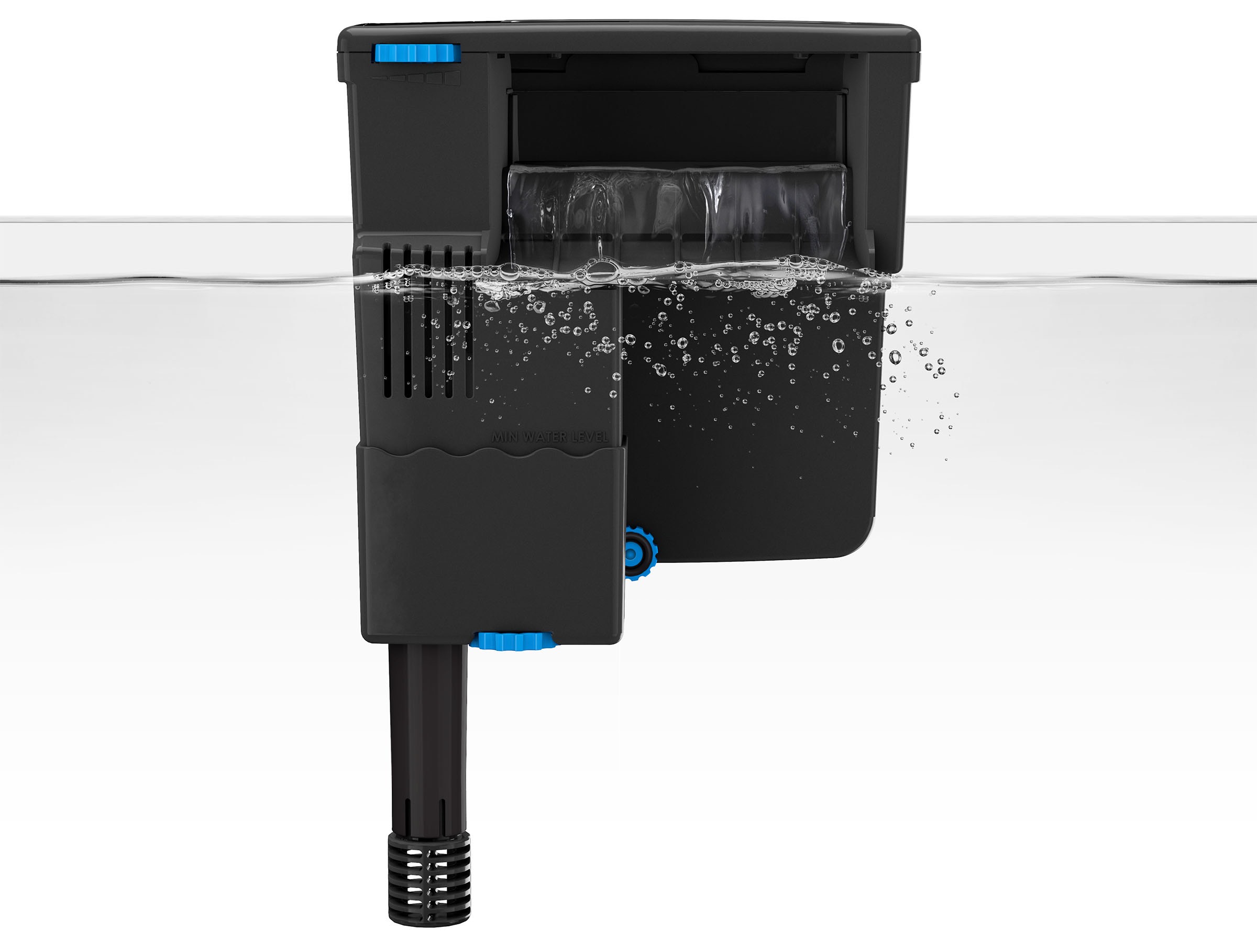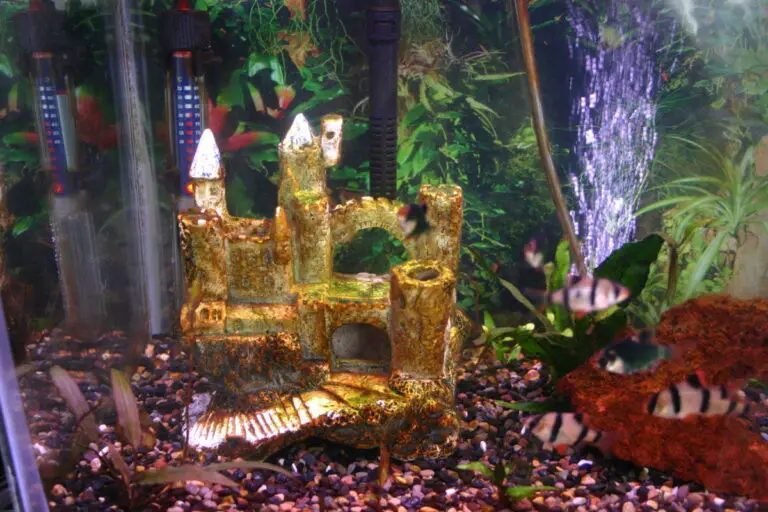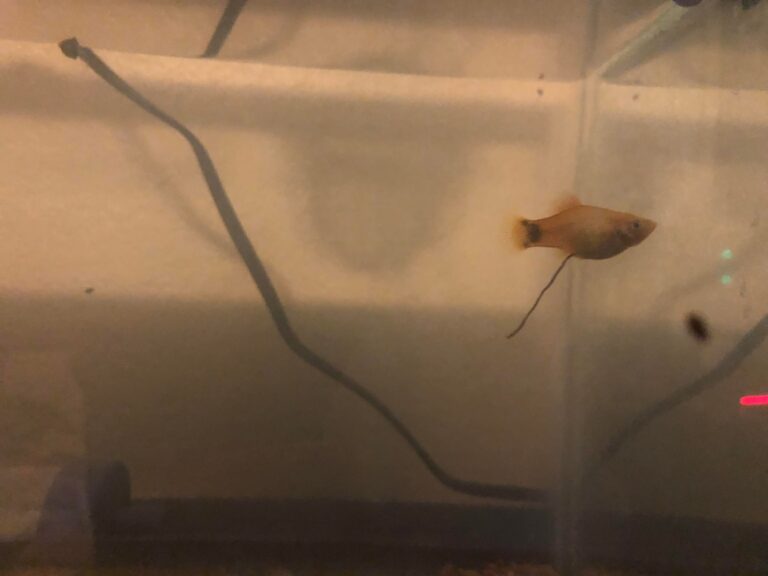Water Level for Fish Tank Filter: Maximizing Efficiency for Optimal Performance
The water level for a fish tank filter is important for maintaining optimal filtration and water quality. This article will explore the significance of water level and provide recommendations for keeping it at the appropriate level to ensure the health and well-being of your aquarium inhabitants.
We’ll discuss the potential problems that can arise from incorrect water levels, such as reduced filtration effectiveness and stress on the filter motor. Additionally, we’ll offer practical tips on how to monitor and adjust the water level to achieve the best filtration results and create a suitable habitat for your fish.
By understanding the importance of water level in fish tank filters, you can establish a proper maintenance routine and keep your aquarium ecosystem thriving.

Credit: www.seachem.com
Why Water Level Matters?
How Water Level Affects Filter Performance?
Maintaining the proper water level in your fish tank is crucial for ensuring the optimal performance of your filter system. The water level directly impacts the efficiency of the filtration process and the overall well-being of your aquatic pets. Let’s take a closer look at how water level affects filter performance.
- Proper water flow: A consistent and adequate water level is necessary to maintain proper filtration. When the water level is too low, the filter may struggle to draw in water, leading to reduced filtration efficiency. On the other hand, if the water level is too high, it can cause excessive splashing and disrupt the filter’s ability to function effectively.
- Circulation and oxygenation: The water level plays a vital role in facilitating the circulation of water in the tank. Efficient circulation helps to distribute oxygen and nutrients evenly, promoting a healthy environment for your fish. Insufficient water level can impede water circulation, leading to low oxygen levels and poor water quality.
- Preventing air intake: Most filters work by drawing water through an intake tube. If the water level is too low, there is a risk of sucking air into the system, which can disrupt the filter’s performance. Air bubbles can obstruct the impeller or cause the filter to produce noisy vibrations.
- Maintaining biological filtration: Proper water level ensures effective biological filtration, which is essential for removing harmful toxins from the tank. When the water level drops, the beneficial bacteria responsible for breaking down ammonia and nitrite may not receive enough water flow to thrive. This can result in poor water quality and compromised fish health.
Common Problems Caused By Incorrect Water Level
Maintaining the correct water level in your fish tank is vital to prevent various issues that can negatively impact both your fish and the filter system. Here are some common problems associated with incorrect water level:
- Insufficient filtration: If the water level is too low, the filter may not be able to draw water effectively, resulting in reduced filtration capacity. This can lead to the accumulation of debris, excess waste, and harmful substances, compromising the water quality and the health of your fish.
- Inadequate oxygenation: Insufficient water level can limit the oxygen exchange at the surface, leading to low oxygen levels in the tank. Fish require a sufficient supply of oxygen to breathe and maintain their overall well-being. Low oxygen levels can cause stress, weakened immune systems, and even fish fatalities.
- Increased noise and vibrations: When the water level is too high, the filter may produce excessive splashing and vibrations. This can be disruptive and noisy, causing discomfort to both you and your fish.
- Imbalance in water chemistry: Incorrect water level can disrupt the delicate balance of water chemistry in your tank. Fluctuations in ph, temperature, and other parameters can stress your fish and make them more susceptible to diseases.
By understanding the importance of maintaining the correct water level and the potential problems that arise from incorrect levels, you can ensure a healthy and thriving aquatic environment for your fish.
Remember, monitoring and adjusting the water level in your fish tank should be part of your regular maintenance routine to guarantee optimal filter performance and the well-being of your aquatic pets.
Optimizing Water Level
Key Considerations For Maintaining The Right Water Level
Maintaining the right water level in your fish tank filter is essential for the overall health and wellbeing of your aquatic friends. It ensures optimal filtration and keeps the water clean and clear. Here are some key considerations to keep in mind when it comes to optimizing the water level in your fish tank:
- Water level stability: Consistency is key when it comes to the water level in your fish tank. Sudden fluctuations in the water level can cause stress to your fish and disrupt the biological balance of the tank. Aim to maintain a stable water level to provide a comfortable environment for your underwater companions.
- The recommended level: Different filters require different water levels for efficient operation. Check the manufacturer’s instructions or consult a professional to determine the ideal water level for your specific filter model. Typically, the water level should be set just below the overflow pipe or inlet to ensure proper filtration.
- Surface agitation: Adequate surface agitation is crucial to promote gas exchange and oxygenation in the water. This is particularly important for tanks with natural plants and sensitive fish species. Adjust the water level to create gentle ripples or bubbles on the water surface, ensuring a healthy oxygen supply for your aquatic inhabitants.
- Evaporation control: Over time, water in your tank will naturally evaporate. Regularly monitor the water level and top up with dechlorinated water as needed. It’s important to maintain a consistent water level to avoid concentration changes in the tank, which can impact the health of your fish and other aquatic organisms.
- Consider tank inhabitants: Some fish and invertebrates have specific water requirements, including preferred water depth. Take into account the natural habitat of your tank inhabitants and adjust the water level accordingly. For example, species that prefer shallow waters may benefit from slightly lower water levels, while others might require deeper water for comfort and natural behavior.
- Preventing overflow: It’s essential to set the water level below the overflow point to prevent any potential flooding or water spills. This ensures that water is directed towards the filter system and not overflowing onto your floor or electrical components. Regularly check the water level and adjust it if necessary to maintain a safe and secure environment for your tank.
- Cleaning and maintenance: Keeping the water level optimized also facilitates easier cleaning and maintenance of your fish tank filter. With the right water level, debris and waste are more effectively directed towards the filter system, allowing for efficient removal during regular cleaning routines.
- Monitoring water quality: A properly maintained water level plays a vital role in maintaining good water quality in your tank. Regularly test the water parameters, such as ph, ammonia, nitrate, and temperature, to ensure they are within acceptable ranges. Adjusting the water level, if necessary, can help maintain the desired water quality for a thriving aquarium ecosystem.
By considering these key points and maintaining the right water level, you can provide an optimal environment for your fish and other aquatic inhabitants. Regular monitoring and adjustments ensure the longevity and effectiveness of your filter system, promoting the overall health and happiness of your underwater friends.
Water Level For Internal Filters
Maintaining the right water level in your fish tank is crucial for the optimal performance of your internal filter. The water level affects the filter’s efficiency in keeping your tank water clean and healthy for your fish. In this section, we will discuss the factors to consider for internal filters and provide some tips on maintaining the optimal water level.
Factors To Consider For Internal Filters
When it comes to internal filters, the water level plays a significant role in their effectiveness. Here are some factors to keep in mind:
- Manufacturer’s recommendations: Always refer to the manufacturer’s instructions or guidelines for the ideal water level specific to your internal filter model. Different filters may have different requirements, so it’s essential to follow the guidance provided.
- Filter design: The design of your internal filter will also determine the water level it requires. Some filters may need a higher water level to function optimally, while others may work better with a lower water level. Understanding your filter’s design will help you maintain the correct water level.
- Fish and plant needs: Consider the needs of your fish and aquatic plants when determining the water level for your internal filter. Some species prefer higher water levels, while others may thrive in lower water levels. Research the requirements of your fish and plants to ensure you maintain a suitable water level that meets their needs.
- Water circulation: Internal filters rely on water flow to effectively filter the tank water. Maintaining the proper water level helps ensure adequate water circulation, allowing the filter to perform its intended function efficiently. Proper circulation prevents stagnation and improves overall water quality.
Tips For Maintaining Optimal Water Level
To maintain the ideal water level for your internal filter, consider the following tips:
- Regular monitoring: Regularly check the water level in your fish tank to ensure it remains within the recommended range. Aim to maintain a consistent water level to prevent any fluctuations that could impact the filter’s performance.
- Adjustment as needed: If you find that the water level is consistently too high or too low, adjust it accordingly. Most internal filters have adjustable flow rates, which allows you to regulate the water level to meet the specific requirements of your setup.
- Avoid overfilling: It’s crucial not to overfill your fish tank, as this can lead to water spillage and potential damage to electrical components of your internal filter. Follow the manufacturer’s instructions and guidelines on how much water your tank can accommodate.
- Regular maintenance: Performing regular maintenance on your internal filter, such as cleaning and replacing filter media, is essential for its proper functioning. During these maintenance routines, also check and adjust the water level as necessary.
- Observe your fish: Keep an eye on your fish’s behavior and health indicators. If you notice any signs of stress or discomfort, such as excessive hiding or gasping at the water surface, it could indicate an issue with the water level or filter performance. Make adjustments accordingly to ensure a healthy environment for your fish.
Maintaining the correct water level for your internal filter is vital for providing a clean and thriving aquarium for your fish. By considering the various factors and following the tips mentioned above, you can ensure that your filter operates efficiently and maintains optimal water conditions in your fish tank.
Water Level For External Filters
External filters are a popular choice for fish tank owners due to their efficiency and ability to keep the water clean. However, maintaining the correct water level is crucial to ensure these filters work effectively. Here are some factors to consider and techniques to maximize the efficiency of your external filter:
Factors To Consider For External Filters:
- Water level: The water level in your fish tank plays a vital role in the proper functioning of an external filter. It is important to keep the water level at the recommended height, typically around the halfway mark of the aquarium. This ensures that the filter can intake water adequately without any disruptions.
- Water flow: Correct water flow is essential for the external filter to function efficiently. Adjust the flow rate to maintain an adequate flow through the filter media. A slow flow can result in limited filtration, while a high flow may cause excessive turbulence and disrupt the tank’s ecosystem.
- Filter media: Choosing the right filter media is crucial for effective filtration. Ensure that you use the media recommended by the manufacturer for your specific external filter model. Regularly clean or replace the filter media as per the manufacturer’s instructions to maintain optimal performance.
- Filter maintenance: Proper maintenance is a key factor in ensuring the longevity and efficiency of external filters. Regularly check and clean the filter components, such as impellers and intake pipes, to prevent clogging. Additionally, monitor the condition of o-rings and gaskets and replace them if necessary to prevent leaks.
Techniques For Maximizing Efficiency:
- Proper priming: Before starting the filter, make sure it is properly primed to remove any air bubbles from the system. Air trapped in the filter can disrupt the water flow and reduce its efficiency. Follow the manufacturer’s instructions for priming your specific filter model.
- Positioning: Place the external filter at the correct height in relation to the tank. Ideally, the filter should be positioned slightly below the water level to allow for easy water intake. Incorrect positioning may cause difficulties in maintaining the water level and impact the filter’s performance.
- Regular cleaning: Regularly clean the external filter to prevent the accumulation of debris and ensure uninterrupted filtration. Clean the impeller and intake tubes to remove any obstructions that may hinder water flow. This practice helps maintain peak performance and extends the lifespan of the filter.
- Check for leaks: Periodically inspect the filter for any signs of leaks. A leaking filter can cause water loss and affect the filter’s efficiency. Ensure that all connections and seals are secure and in good condition. Address any leaks immediately to prevent further issues.
Remember, maintaining the correct water level and optimizing the performance of your external filter is essential for a healthy and thriving fish tank. By considering the factors mentioned above and implementing the techniques for maximizing efficiency, you can ensure that your external filter operates at its best, providing clean and clear water for your aquatic companions.
Troubleshooting Water Level Issues
Keeping the water level in your fish tank filter at the right level is crucial for maintaining a healthy and functioning aquarium. When the water level is off, it can lead to a range of issues, from poor filtration to potential damage to your equipment.
In this section, we’ll explore some common water level problems and provide solutions to help you troubleshoot and resolve them effectively.
Identifying Problems With Water Level
- Insufficient water level:
- Fish behavior changes: If you notice your fish spending most of their time near the surface or gasping for air, it could be a sign of low water level.
- Decreased filter efficiency: A low water level can cause reduced water flow through the filter, leading to inefficient filtration and potentially harmful water conditions.
- Excessive water level:
- Overflowing tank: If your tank is constantly overflowing, it’s a clear indication that the water level is too high.
- Noise from filter: An unusually loud noise coming from the filter can be an indication that the water level is higher than it should be.
Solutions For Common Water Level Issues
- Insufficient water level:
- Adjust filter intake: Make sure the filter intake tube is positioned correctly and fully submerged in the water. If not, adjust it accordingly.
- Check water evaporation: Monitor the water level regularly and top up the tank whenever necessary to compensate for natural evaporation.
- Reduce splashing: If you have a waterfall or other features causing excessive water splashing, consider reducing their flow or adjusting their position.
- Excessive water level:
- Lower water level: Carefully drain some water from the tank to reduce the water level. Use a siphon or container to remove excess water without disturbing the fish and decor.
- Check filter setup: Ensure that the filter is properly installed and that the water flow is not obstructed. Adjust the filter settings if necessary.
- Optimize tank decorations: Sometimes, tall or dense decorations in your tank can disrupt water flow, leading to high water levels. Rearrange or remove decorations as needed.
Maintaining the proper water level in your fish tank filter is essential for the well-being of your aquatic friends. By identifying water level problems and implementing the appropriate solutions, you can ensure a healthy and thriving aquarium environment. Remember to regularly monitor and adjust the water level to keep your fish happy and your filter working effectively.
Frequently Asked Questions On Water Level For Fish Tank Filter
What Is The Ideal Water Level For A Fish Tank Filter?
The ideal water level for a fish tank filter is typically one to two inches below the top of the tank. This allows for proper water circulation and prevents the filter from overflowing. Maintaining the correct water level ensures that the filter can effectively remove debris and waste, keeping your tank clean and your fish healthy.
What Happens If The Water Level In The Fish Tank Filter Is Too High?
If the water level in the fish tank filter is too high, it can cause the filter to overflow. This can lead to water spilling out of the tank and potentially damaging the surrounding area. Additionally, an excessively high water level can disrupt the filter’s efficiency, reducing its ability to effectively clean the water and maintain the tank’s ecosystem.
What Happens If The Water Level In The Fish Tank Filter Is Too Low?
If the water level in the fish tank filter is too low, it can hinder the filter’s performance. A low water level may cause the filter to suck in air instead of water, leading to inadequate filtration and a decrease in oxygen levels for your fish.
It’s crucial to maintain the proper water level to ensure the filter functions optimally and keeps your tank environment healthy.
How Often Should I Check And Adjust The Water Level In My Fish Tank Filter?
It’s recommended to regularly check the water level in your fish tank filter at least once a week. Depending on the evaporation rate in your tank, you may need to adjust the water level more frequently. By keeping a close eye on the water level, you can ensure the filter is functioning properly and make any necessary adjustments to maintain an optimal environment for your fish.
What Are Some Methods For Adjusting The Water Level In A Fish Tank Filter?
To adjust the water level in a fish tank filter, you can add or remove water using a siphon or a bucket. When the water level is too high, use the siphon or bucket to remove excess water until it reaches the desired level.
Conversely, if the water level is too low, add water from a bucket to bring it up to the appropriate level. Regular monitoring and adjustment will help maintain a healthy balance for your fish tank.
Conclusion
Maintaining the right water level in your fish tank filter is crucial for the well-being of your aquatic friends. By following the manufacturer’s recommendations and regularly monitoring the water level, you can ensure that the filter functions optimally, providing clean and healthy water for your fish.
Remember, too low of a water level can cause the filter to overwork, while too high of a water level can lead to water bypassing the filter media. It’s important to strike a balance and make adjustments as needed. Additionally, a properly maintained water level will prevent unnecessary stress on your fish and help create a stable and thriving environment for them.
Monitoring and maintaining the water level in your fish tank filter is just one of the many ways to ensure the overall health and happiness of your aquatic pets.






